Searching for New Directions for Energy Policy: Testing the Cross-Effect of Risk Perception and Cyberspace Factors on Online/Offline Opposition to Nuclear Energy in South Korea
Abstract
1. Introduction
2. Theoretical Background and Hypothesis
2.1. Risk Perception Paradigm versus Cyberpsychology
2.2. Risk Perception Paradigm
2.3. Cyberpsychology Paradigm
2.4. Moderation Effect
3. Data and Measures
4. Analysis and Findings
4.1. Basic Structure
4.2. Causal Structure
4.3. Interaction Structure
5. Conclusions and Implications
5.1. Summary
5.2. Implications
5.3. Limitations
Author Contributions
Funding
Conflicts of Interest
References
- Li, N.; Akin, H.; Su, L.; Brossard, D.; Xenos, M.; Scheufele, D.A. Tweeting disaster: An analysis of online discourse about nuclear power in the wake of the Fukushima Daiichi nuclear accident. J. Sci. Commun. 2016, 15, 1–20. [Google Scholar] [CrossRef]
- Anderson, A.A.; Brossard, D.; Scheufele, D.A. The changing information environment for nanotechnology: Online audiences and content. J. Nanopart. Res. 2010, 12, 1083–1094. [Google Scholar] [CrossRef] [PubMed]
- Friedman, S.M. Three Mile Island, Chernobyl, and Fukushima: An analysis of traditional and new media coverage of nuclear accidents and radiation. Bull. At. Sci. 2011, 67, 55–65. [Google Scholar] [CrossRef]
- World Internet Users Statistics and 2016 World Population Stats. Available online: https://www.internetworldstats.com/stats.htm (accessed on 20 August 2018).
- Internet Used by 3.2 Billion People in 2015. Available online: https://www.bbc.com/news/technology-32884867 (accessed on 22 August 2018).
- ICT Data and Statistics (IDS); International Telecommunication Union (ITU). Internet users per 100 inhabitants 1997 to 2007. (accessed on 17 May 2015).
- Kurečić, P.; Miljković, P.; Bagarić, P. The importance of the internet in forming of the public opinion and its indispensability for contemporary economy: An online survey. In Proceedings of the 27th International Scientific Conference on Economic and Social Development, Rome, Italy, 1–2 March 2018. [Google Scholar]
- Blair, A. Democratising the Learning Process: The Use of Twitter in the Teaching of Politics and International Relations. Politics 2013, 33, 135–145. [Google Scholar] [CrossRef]
- Dahlgren, P. The Internet, public spheres, and political communication: Dispersion and deliberation. Political Commun. 2005, 22, 147–162. [Google Scholar] [CrossRef]
- Miyata, K.; Yamamoto, H.; Ogawa, Y. What Affects the Spiral of Silence and the Hard Core on Twitter? An Analysis of the Nuclear Power Issue in Japan. Am. Behav. Sci. 2015, 59, 1129–1141. [Google Scholar] [CrossRef]
- Visschers, V.; Siegrist, M. Differences in risk perception between hazards and between individuals. In Psychological Perspectives on Risk and Risk Analysis: Theory, Models, and Applications; Raue, M., Lermer, E., Streicher, B., Eds.; Springer International Publishing AG: Cham, Switzerland, 2018; pp. 63–80. [Google Scholar]
- Fischhoff, B.; Slovic, P.; Lichtenstein, S.; Read, S.; Combs, B. How safe is safe enough? A Psychometric study of attitudes towards technological risks and benefits. Policy Sci. 1978, 9, 127–152. [Google Scholar] [CrossRef]
- Siegrist, M.; Keller, C.; Kiers, H.A.L. A new look at the psychometric paradigm of perception of hazards. Risk Anal. 2005, 25, 211–222. [Google Scholar] [CrossRef] [PubMed]
- Siegrist, M.; Earle, T.C.; Gutscher, H. Perception of risk: The influence of general trust, and general confidence. J. Risk Res. 2005, 8, 145–156. [Google Scholar] [CrossRef]
- Marris, C.; Langford, I.; Saunderson, T.; O’Riordan, T. Exploring the “psychometric paradigm”: Comparisons between aggregate and individual analyses. Risk Anal. 1997, 17, 303–312. [Google Scholar] [CrossRef] [PubMed]
- Beyth-Marom, R.; Fischhoff, B. Adolescent decisions about risk: A cognitive perspective. In Health Risks and Developmental Transaction During Adolescence; Schulenberg, J., Maggs, J., Hurnelmans, K., Eds.; Cambridge University Press: New York, NY, USA, 1997; pp. 110–135. [Google Scholar]
- Slovic, P.; Lichtenstein, S.; Fischoff, B. Facts and fears: Understanding perceived risk. In Societal Risk Assessment: How Safe is Safe Enough? Schwing, R.C., Albers, W.A., Eds.; Plenum: New York, NY, USA, 1980; pp. 67–93. [Google Scholar]
- Fischhoff, B. “Acceptable risk”: The case of nuclear power. J. Policy Anal. Manag. 1983, 2, 559–575. [Google Scholar] [CrossRef]
- Fischhoff, B.; Downs, J.; Bruine de Bruin, W. Adolescent vulnerability: A framework for behavioral interventions. Appl. Prev. Psychol. 1998, 7, 77–94. [Google Scholar] [CrossRef]
- Fischhoff, B.; Parker, A.; Bruine de Bruin, W. Teen expectations for significant life events. Public Opin. Q. 2000, 64, 189–205. [Google Scholar] [CrossRef] [PubMed]
- Siegrist, M. The influence of trust and perceptions of risks and benefits on the acceptance of gene technology. Risk Anal. 2000, 20, 195–204. [Google Scholar] [CrossRef] [PubMed]
- Zein, R.A.; Suhariadi, F.; Wardana, N.D.; Hendriani, W. Investigating Determinants of Lay Knowledge, Stigma and Health-Risk Perception of Pulmonary Tuberculosis in Surabaya, Indonesia. Available online: http://osf.io/nuxq3 (accessed on 18 July 2018).
- Blascovich, J.; Bailenson, J. Infinite Reality: Avatars, Eternal Life, New Worlds, and the Dawn of the Virtual Revolution, 1st ed.; William Morrow: New York, NY, USA, 2011. [Google Scholar]
- Whitty, M.T.; Young, G. Cyberpsychology: The Study of Individuals, Society and Digital Technologies; Wiley Blackwell: Hoboken, NJ, USA, 2016. [Google Scholar]
- Kirwan, G. Cyberpsychology. Ir. J. Psychol. 2010, 31, 69–84. [Google Scholar] [CrossRef]
- Suler, J. Psychology of the Digital Age: Humans Become Electric; Cambridge University Press: Cambridge, UK, 2016. [Google Scholar]
- Yee, N.; Bailenson, J.N.; Ducheneaut, N. The proteus effect: Implications of transformed digital self-representation on online and offline behavior. Commun. Res. 2009, 36, 285–312. [Google Scholar] [CrossRef]
- Zhou, Y.; Moy, P. Parsing framing processes: The interplay between online public opinion and media coverage. J. Commun. 2007, 57, 79–98. [Google Scholar] [CrossRef]
- Visschers, V.H.; Siegrist, M. How a nuclear power plant accident influences acceptance of nuclear power: Results of a longitudinal study before and After the Fukushima disaster. Risk Anal. 2013, 33, 333–347. [Google Scholar] [CrossRef] [PubMed]
- Stoutenborough, J.W.; Sturgess, S.G.; Vedlitz, A. Knowledge, risk, and policy support: Public perceptions of nuclear power. Energy Policy. 2013, 62, 176–184. [Google Scholar] [CrossRef]
- Roh, S.; Jin, W.L. Differentiated influences of risk perceptions on nuclear power acceptance according to acceptance targets: Evidence from Korea. Nucl. Eng. Technol. 2017, 49, 1090–1094. [Google Scholar] [CrossRef]
- Alhakami, A.S.; Slovic, P. A psychological study of the inverse relationship between perceived risk and perceived benefit. Risk Anal. 1994, 14, 1085–1096. [Google Scholar] [CrossRef] [PubMed]
- Kim, G.; Kim, S. An empirical study of the effect of the multidimensionality of perceived benefits on acceptance of nuclear power. Korean J. Policy Stud. 2017, 55, 207–245. [Google Scholar]
- Ryu, Y.; Kim, S.; Kim, S. Does trust matter? analyzing the impact of trust on the perceived risk and acceptance of nuclear power energy. Sustainability 2018, 10, 758. [Google Scholar] [CrossRef]
- Yang, S.; Cho, S.I. Middle East respiratory syndrome risk perception among students at a university in South Korea. Am. J. Infect Control 2017, 45, 53–60. [Google Scholar]
- Siegrist, M.; Cvetkovich, G.; Roth, C. Salient value similarity, social trust, and risk/benefit perception. Risk Anal. 2000, 20, 353–362. [Google Scholar] [CrossRef] [PubMed]
- Peters, E.; Slovic, P. The role of affect and worldviews as orienting dispositions in the perception and acceptance of nuclear power. J. Appl. Soc. Psychol. 1996, 26, 1427–1453. [Google Scholar] [CrossRef]
- Slovic, P.; Flynn, J.H.; Layman, M. Perceived risk, trust, and the politics of nuclear waste. Science 1991, 254, 1603–1607. [Google Scholar] [CrossRef] [PubMed]
- Kasperson, R.; Nayna, J.; Kasperson, J.X. Stigma and the Social Amplification of Risk: Toward a Framework of Analysis. In Risk, Media and Stigma: Understanding Public Challenges to Modern Science and Technology; Flynn, J., Slovic, P., Kunreuther, H., Taylor & Francis, Eds.; Earthscan Publications: London, UK, 2001; pp. 9–27. [Google Scholar]
- Slovic, P.; Layman, M.; Kraus, N.; Flynn, J.; Chalmers, J.; Gesell, G. Perceived risk, stigma, and potential economic impacts of a high-level nuclear waste repository in Nevada. Risk Anal. 1991, 11, 683–696. [Google Scholar] [CrossRef] [PubMed]
- Cobb, M.D.; Macoubrie, J. Public perceptions about nanotechnology: Risks, benefits and trust. J. Nanopart. Res. 2004, 6, 395–405. [Google Scholar] [CrossRef]
- Kuklinski, J.H.; Metlay, D.S.; Kay, W.D. Citizen knowledge and choices on the complex issue of nuclear energy. AJPS 1982, 26, 615–642. [Google Scholar] [CrossRef]
- Kim, S.; Kim, S. Exploring the determinants of perceived risk of Middle East Respiratory Syndrome (MERS) in Korea. Int. J. Environ. Res. Public Health 2018, 15, 1168. [Google Scholar] [CrossRef] [PubMed]
- Glanz, K.; Rimer, B.K.; Viswanath, K. Health Behavior and Health Education: Theory, Research, and Practice, 4th ed.; Jossey-Bass: San Francisco, CA, USA, 2008; pp. 45–51. [Google Scholar]
- Ter Huurne, E.F.J.; Gutteling, J.M. How to trust? The importance of self-efficacy and social trust in public responses to industrial risks. J. Risk Res. 2009, 12, 809–824. [Google Scholar] [CrossRef]
- Kim, P.; Kim, S. Analyzing the opposition to nuclear power energy on the internet: Focusing on the moderating effect of policy efficacy. Crisisonomy 2017, 13, 1–15. [Google Scholar] [CrossRef]
- Petty, R.E.; Cacioppo, J.T. Involvement and persuasion: Tradition versus integration. Psychol. Bull. 1990, 107, 367–374. [Google Scholar] [CrossRef]
- Petty, R.E.; Cacioppo, J.T. Issue involvement can increase or decrease persuasion by enhancing message-relevant cognitive response. J. Per. Soc. Psychol. 1979, 37, 1915–1926. [Google Scholar] [CrossRef]
- Chaiken, S. Heuristic versus systematic information processing and the use of source versus message cues in persuasion. J. Per. Soc. Psychol. 1980, 39, 752–766. [Google Scholar] [CrossRef]
- Ryu, Y.; Kim, S. Analyzing Koreans’ risk judgement process in case of Fukushima nuclear accident: The receiver’s involvement and ability in HSM (Heuristic-systematic information processing model). J. Gov. Stud. 2014, 20, 315–342. [Google Scholar]
- Hovland, C.I.; Janis, I.L.; Kelley, H.H. Communication and Persuasion: Psychological Studies of Opinion Change; Yale University Press: New Haven, CT, USA, 1953. [Google Scholar]
- Berdahl, L.; Bourassa, M.; Bell, S.; Fried, J. Exploring perceptions of credible science among policy stakeholder groups: Results of focus group discussions about nuclear energy. Sci. Commun. 2016, 38, 382–406. [Google Scholar] [CrossRef]
- Kim, M.-J.; Lee, C.-K.; Chung, N. Investigating the role of trust and gender in online tourism shopping in South Korea. J. Hosp. Tour. Res. 2013, 37, 377–401. [Google Scholar] [CrossRef]
- Chiang, I.-P.; Su, Y.-H. Measuring and analyzing the causes of problematic internet use. Cyberpsychol. Behav. Soc. Netw. 2012, 15, 591–596. [Google Scholar] [CrossRef] [PubMed]
- Asch, S.E. Opinions and social pressure. Sci. Am. 1955, 193, 33–35. [Google Scholar] [CrossRef]
- Asch, S.E. Effects of group pressure upon modification and distortion of judgments. Readings in Social Psychology, 3rd ed.; Holt, Rinehart & Winston: New York, NY, USA, 1958; pp. 174–183. [Google Scholar]
- Asch, S.E. Studies of independence and conformity: I. A minority of one against a unanimous majority. Psychol. Monogr. 1956, 70, 395–407. [Google Scholar] [CrossRef]
- Rosander, M.; Eriksson, O. Conformity on the Internet—The role of task difficulty and gender differences. Comput. Hum. Behav. 2012, 28, 1587–1595. [Google Scholar] [CrossRef]
- Smilowitz, M.; Compton, C.D.; Flint, L. The effects of computer mediated communication on an individual’s judgment: A study based on the methods of Asch’s social influence experiment. Comput. Hum. Behav. 1988, 4, 311–321. [Google Scholar] [CrossRef]
- Kim, M.; Yoon, Y. Effect of multiple media use and social conformity on perceived credibility and sharing intention of online rumor. J. Public Relat. 2015, 19, 96–119. [Google Scholar]
- Fox, J.; Wai, Y.T. Sexism in online video games: The role of conformity to masculine norms and social dominance orientation. Comput. Hum. Behav. 2014, 33, 314–320. [Google Scholar] [CrossRef]
- Nail, P.R.; MacDonald, G.; Levy, D.A. Proposal of a four-dimensional model of social response. Psychol. Bull. 2000, 126, 454–470. [Google Scholar] [CrossRef] [PubMed]
- DiFonzo, N.; Prashant, B. Rumor. In The Science of Social Influence: Advances and Future Progress; Pratkanis, A.R., Ed.; Psychology: Philadelphia, PA, USA, 2007; pp. 271–296. [Google Scholar]
- Thomas, S.A. Lies, damn lies, and rumors: An analysis of collective efficacy, rumors, and fear in the wake of Katrina. Sociol. Spectr. 2007, 27, 679–703. [Google Scholar] [CrossRef]
- Kim, S.; Kim, S. Impact of the Fukushima nuclear accident on belief in rumors: The role of risk perception and communication. Sustainability 2017, 9, 2188. [Google Scholar] [CrossRef]
- Lee, J.; Park, D.; Han, I. The effect of negative online consumer reviews on product attitude: An information processing view. Electron. Commer. Res. Appl. 2008, 7341–7352. [Google Scholar] [CrossRef]
- Kim, K.H.; Yeo, I.G.; Kim, D.Y. Antecedents and consequences of trusts in on and off line in internet banking. J. Glob. Acad. Mark. Sci. 2004, 13, 159–181. [Google Scholar] [CrossRef]
- Kim, E. A comparative study on social media use and public participation in Korea and the united states: Does social media matter? Korean J. Policy Stud. 2015, 30, 207–230. [Google Scholar]
- Internet usage in South Korea—Statistics & Facts. Available online: https://www.statista.com/topics/2230/internet-usage-in-south-korea/ (accessed on 1 July 2018).
- Passino, E.M.; Lounsbury, J.W. Sex Differences in Opposition to and Support for Construction of a Proposed Nuclear Power Plant. In The Behavioral Basis of Design, Book 1: Selected Papers; Suedefelf, P., Russell, J.A., Eds.; Dowden, Hutchinson, and Ross: Stroudsburg, PA, USA, 1976. [Google Scholar]
- Benford, R.D.; Moore, H.A.; Williams, J.A., Jr. In whose backyard? Concern about siting a nuclear waste facility. Sociol. Inq. 1993, 63, 30–47. [Google Scholar] [CrossRef]
- Wang, J.; Kim, S. Analyzing the change of acceptance and its perception structure about nuclear power. Korea Public Adm. Rev. 2013, 47, 395–424. [Google Scholar]
- Baron, R.M.; Kenny, D.A. The moderator—Mediator variable distinction in social psychological research: Conceptual, strategic, and statistical considerations. J. Pers. Soc. Psychol. 1986, 51, 1173–1182. [Google Scholar] [CrossRef] [PubMed]
- Kim, S. Irresolvable cultural conflicts and conservation/development arguments: Analysis of Korea’s Saemangeum project. Policy Sci. 2003, 2003. 36, 125–149. [Google Scholar] [CrossRef]
- Wang, J.; Kim, S. Analysis of the impact of values and perception on climate change skepticism and its implication for public policy. Climate 2018, 6, 99. [Google Scholar] [CrossRef]
- Kim, S.; Kim, S. Exploring the effect of four factors on affirmative action program for women. AJWS 2014, 20, 31–70. [Google Scholar] [CrossRef]
- Wang, J.; Kim, S. Comparative analysis of public attitudes toward nuclear power energy across 27 European countries by applying the multilevel model. sustainability 2018, 10, 1518. [Google Scholar] [CrossRef]
- Kim, S.; Choi, S.; Wang, J. Individual perception vs. structural context: Searching for multilevel determinants of social acceptance of new science and technology across 34 countries. Sci. Public Policy 2014, 41, 44–57. [Google Scholar] [CrossRef]
- Kim, S.; Kim, D. Does government make people happy?: Exploring new research directions for government’s roles in happiness. J. Happiness Stud. 2012, 13, 875–899. [Google Scholar] [CrossRef]
- Kim, S.; Kim, G. After Fukushima: Exploring the attitude change and its determinants about acceptance of nuclear power. Korea Policy Study Rev. 2014, 23, 59–89. [Google Scholar]
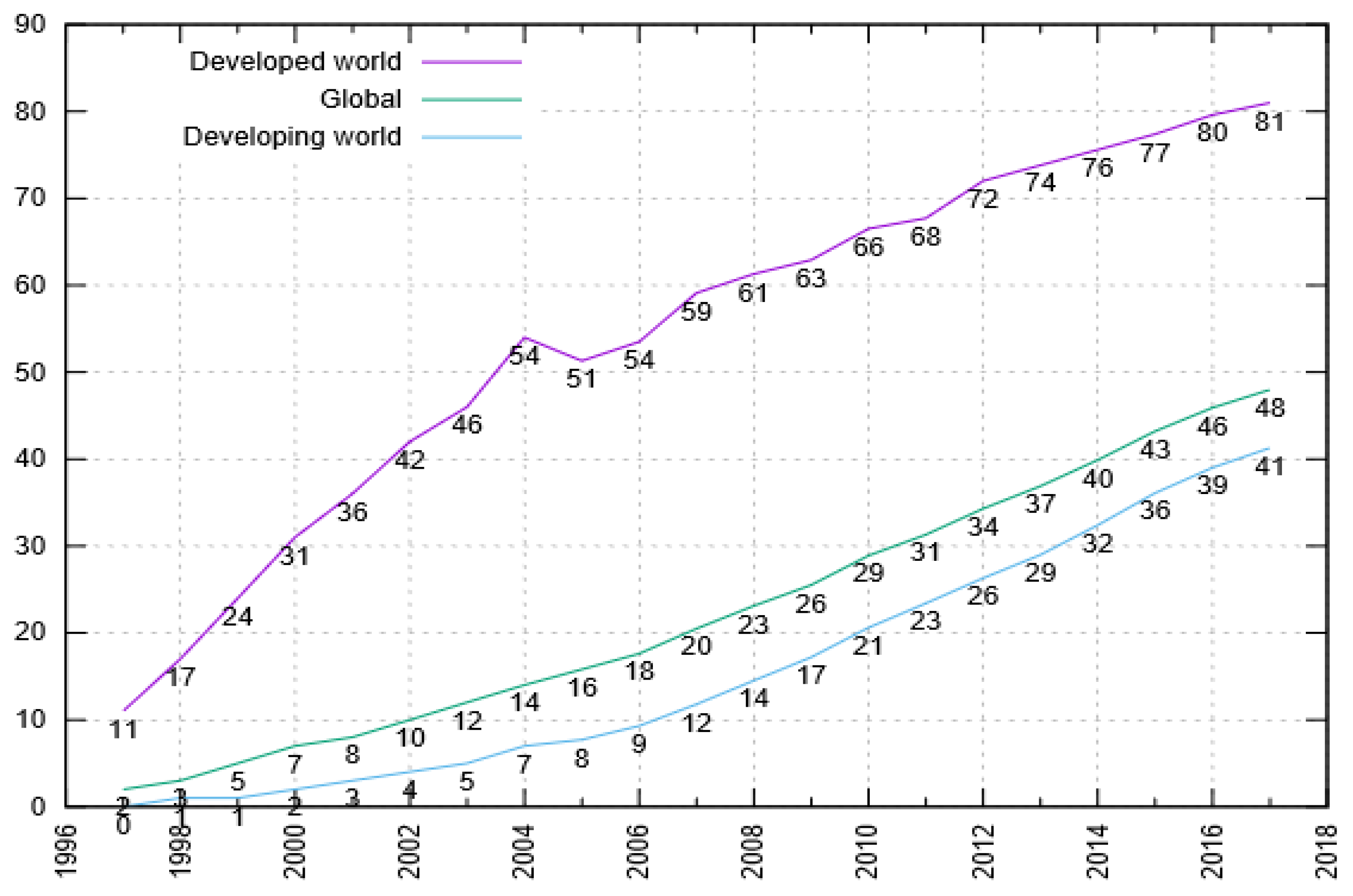
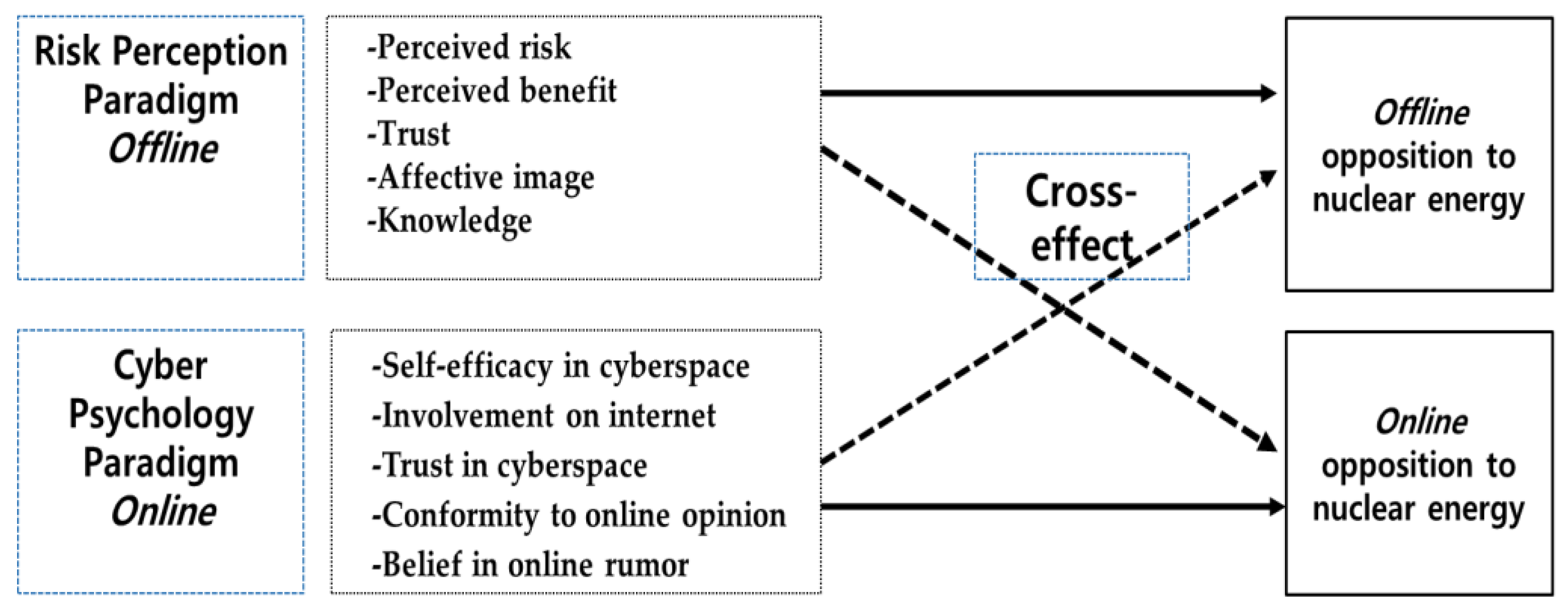
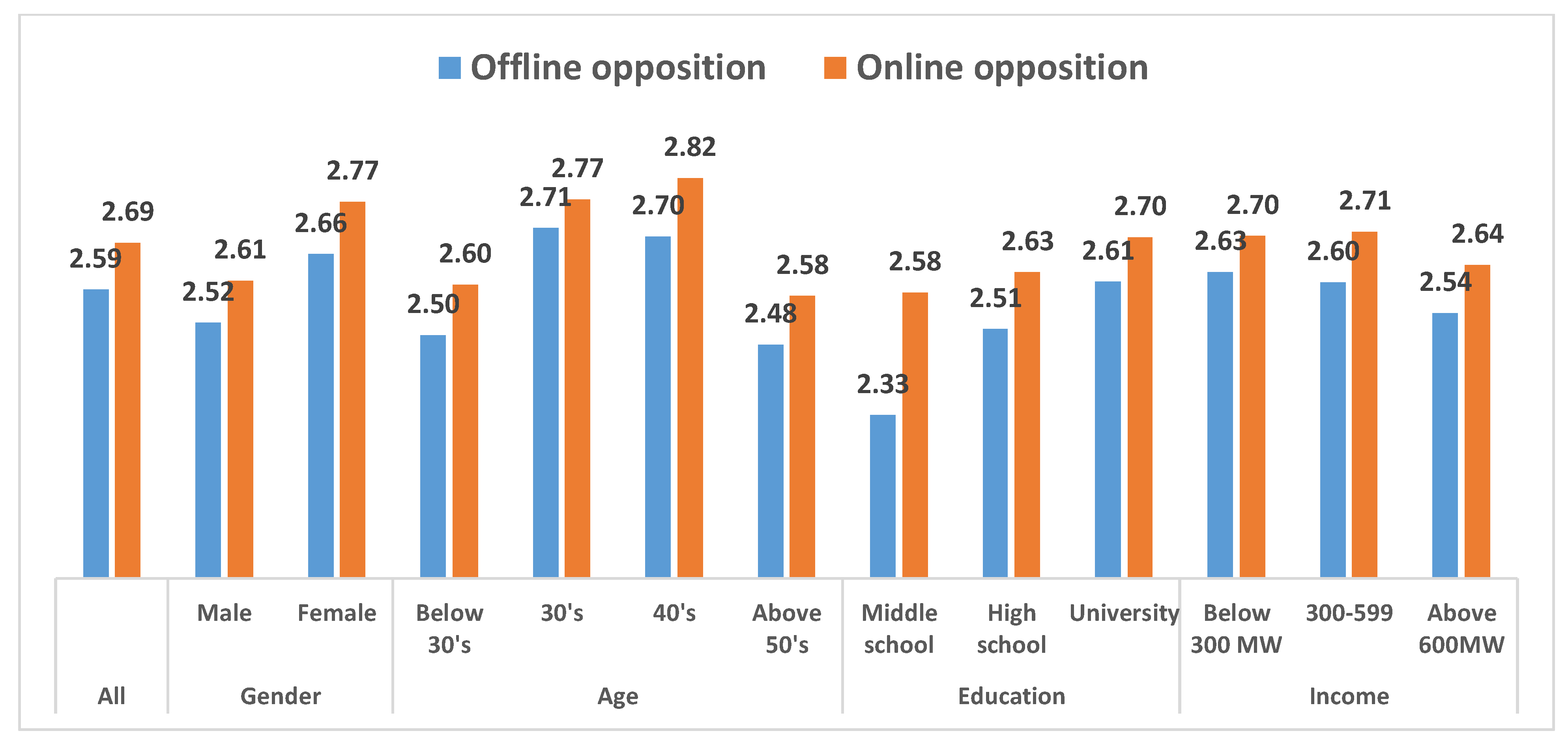
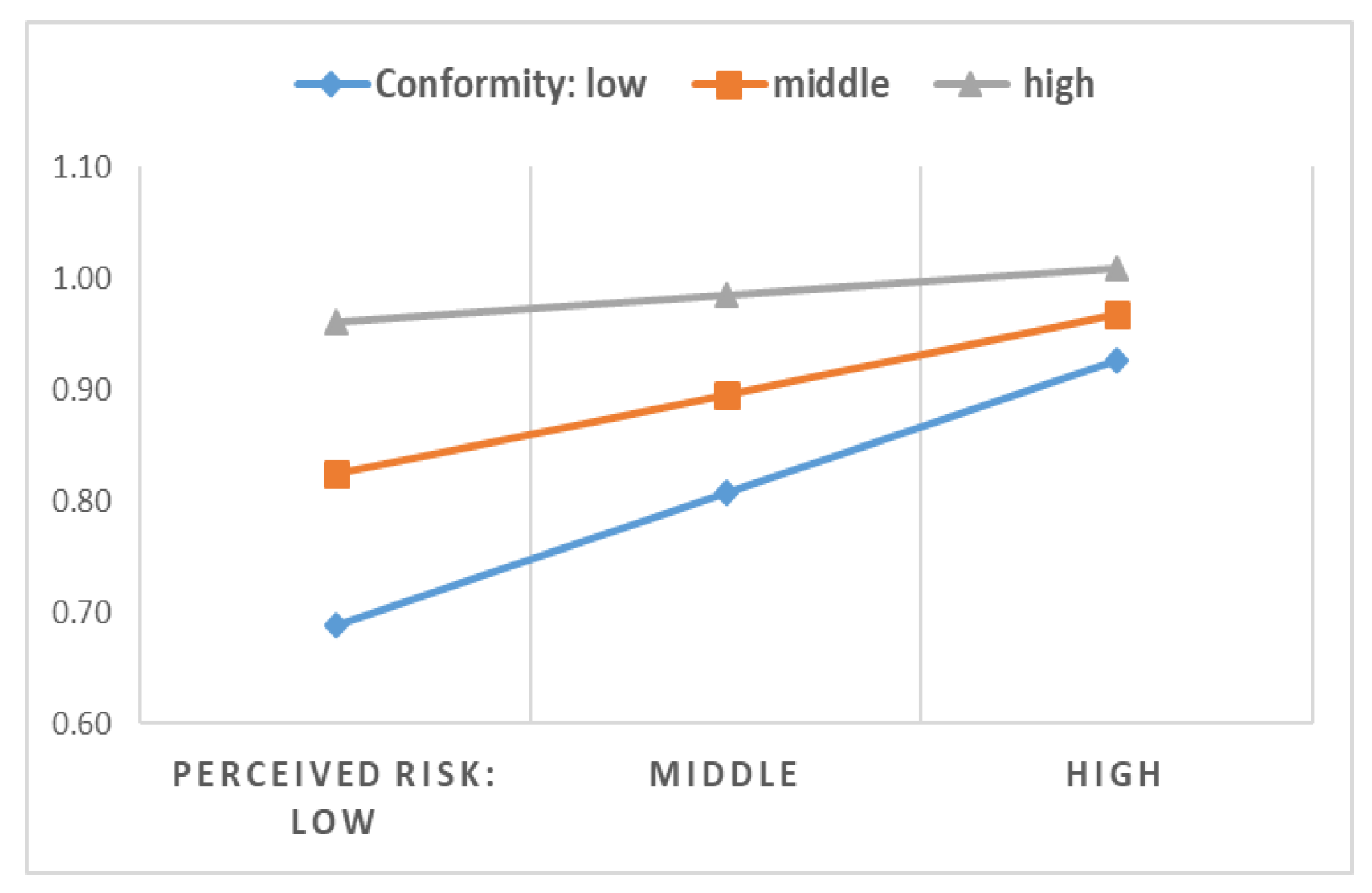
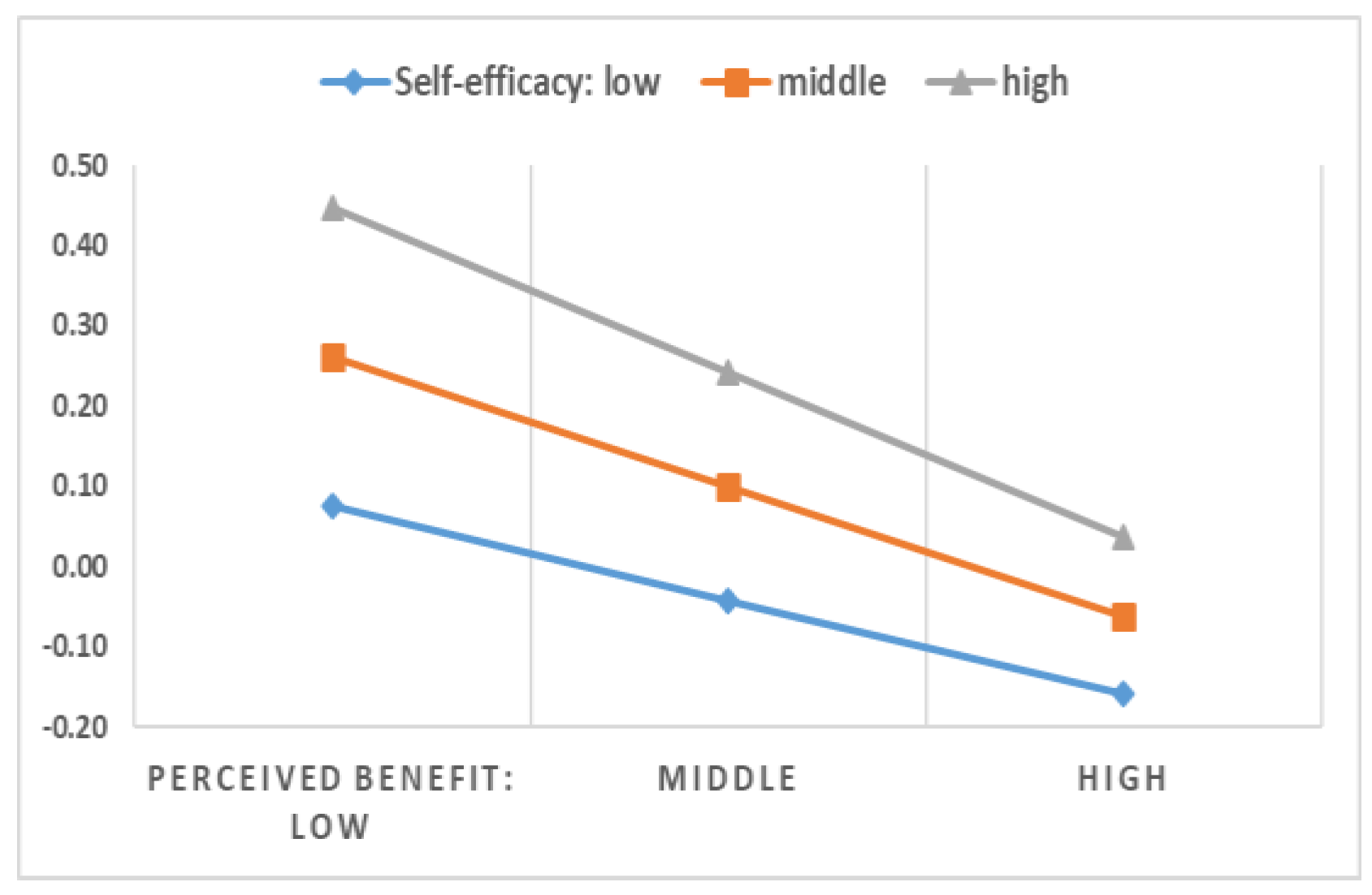
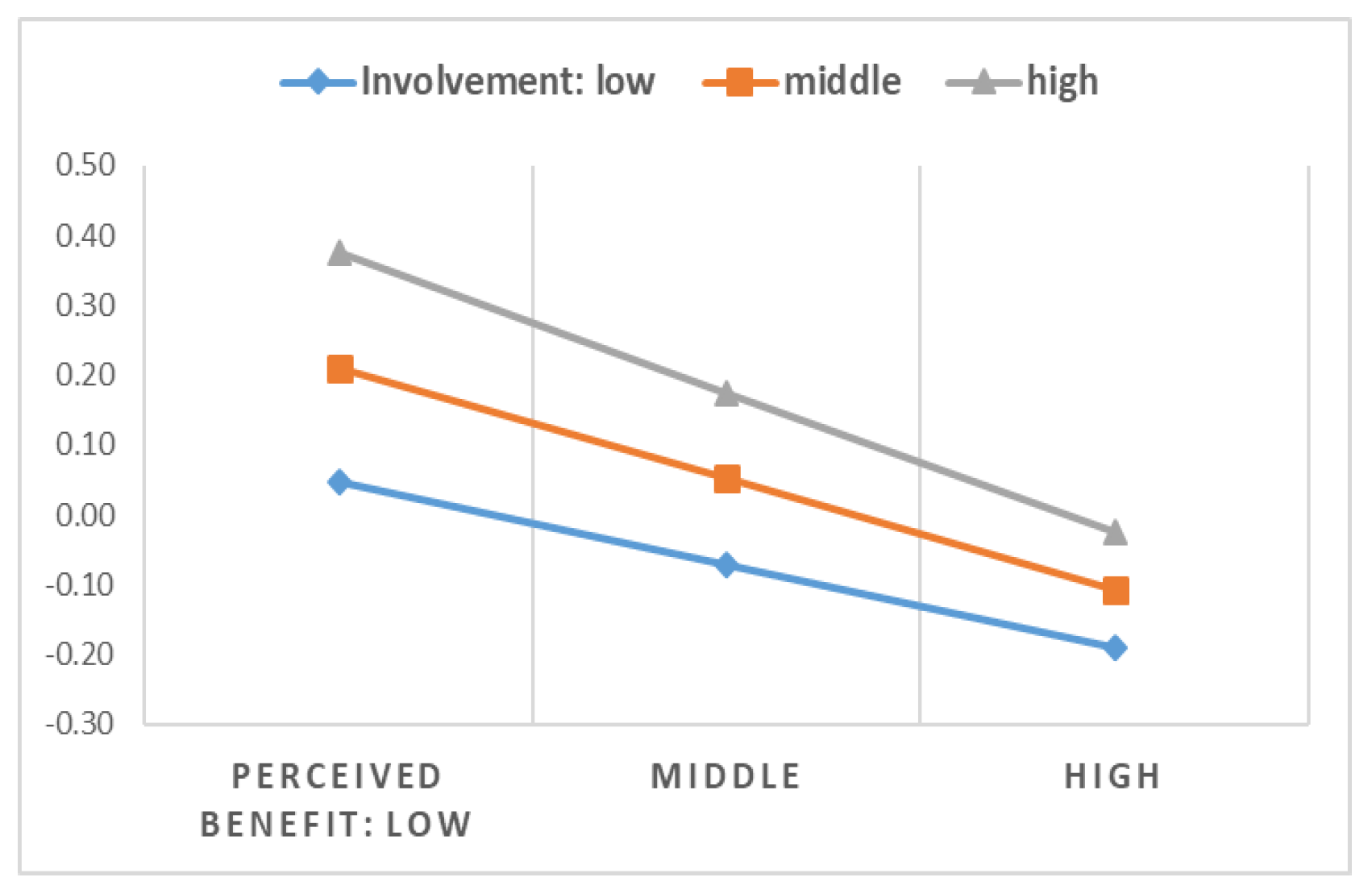
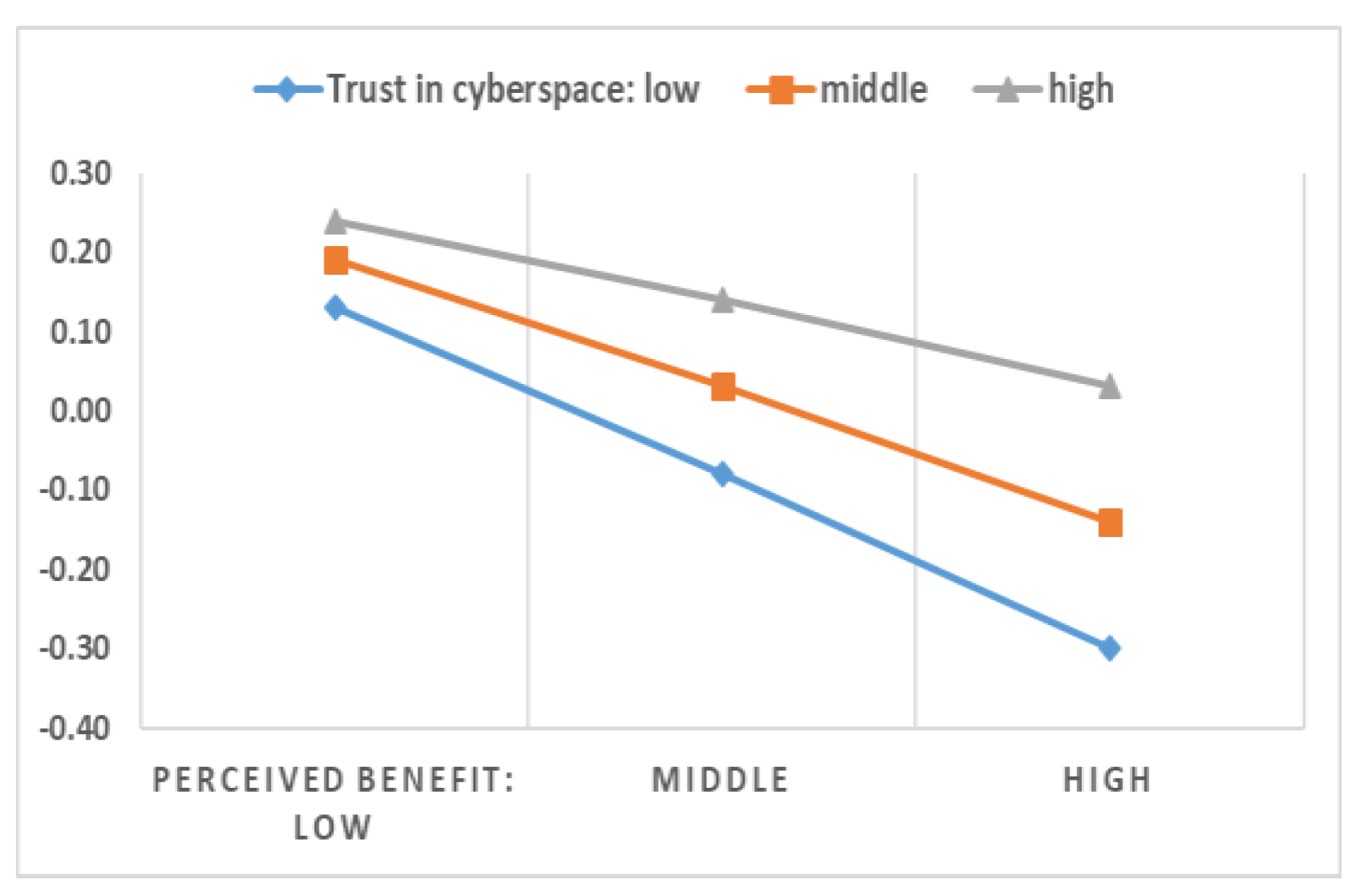
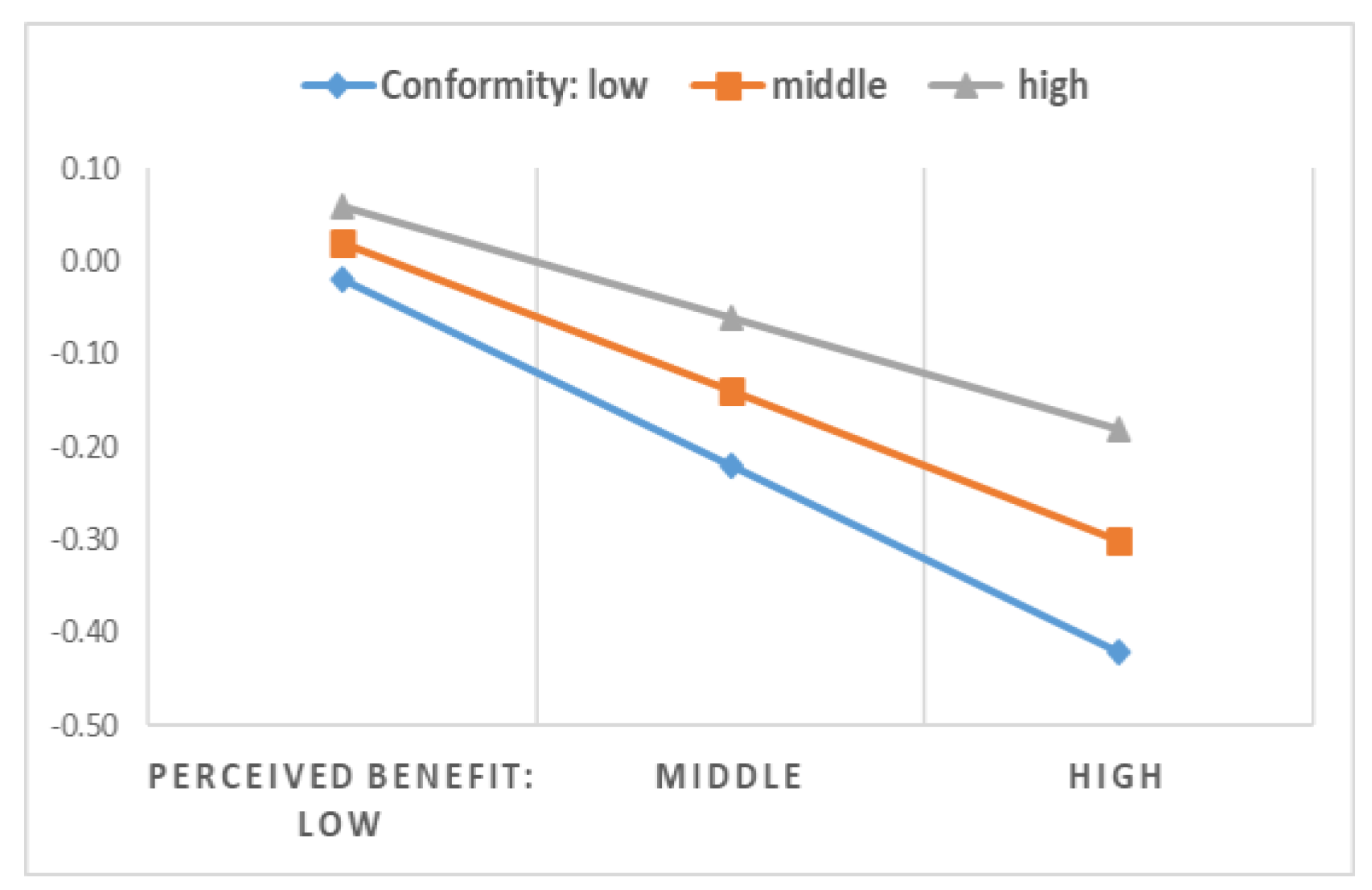
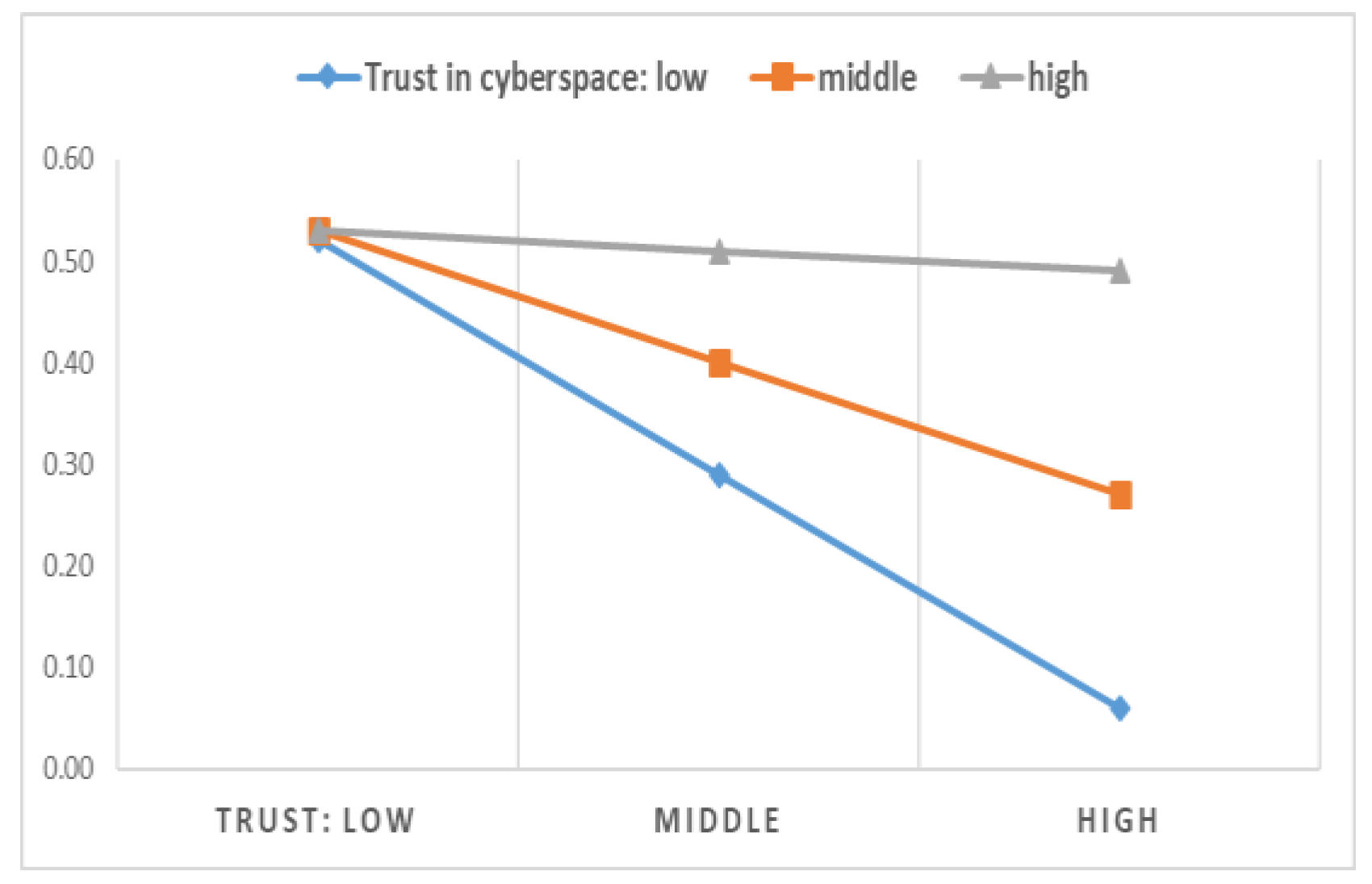
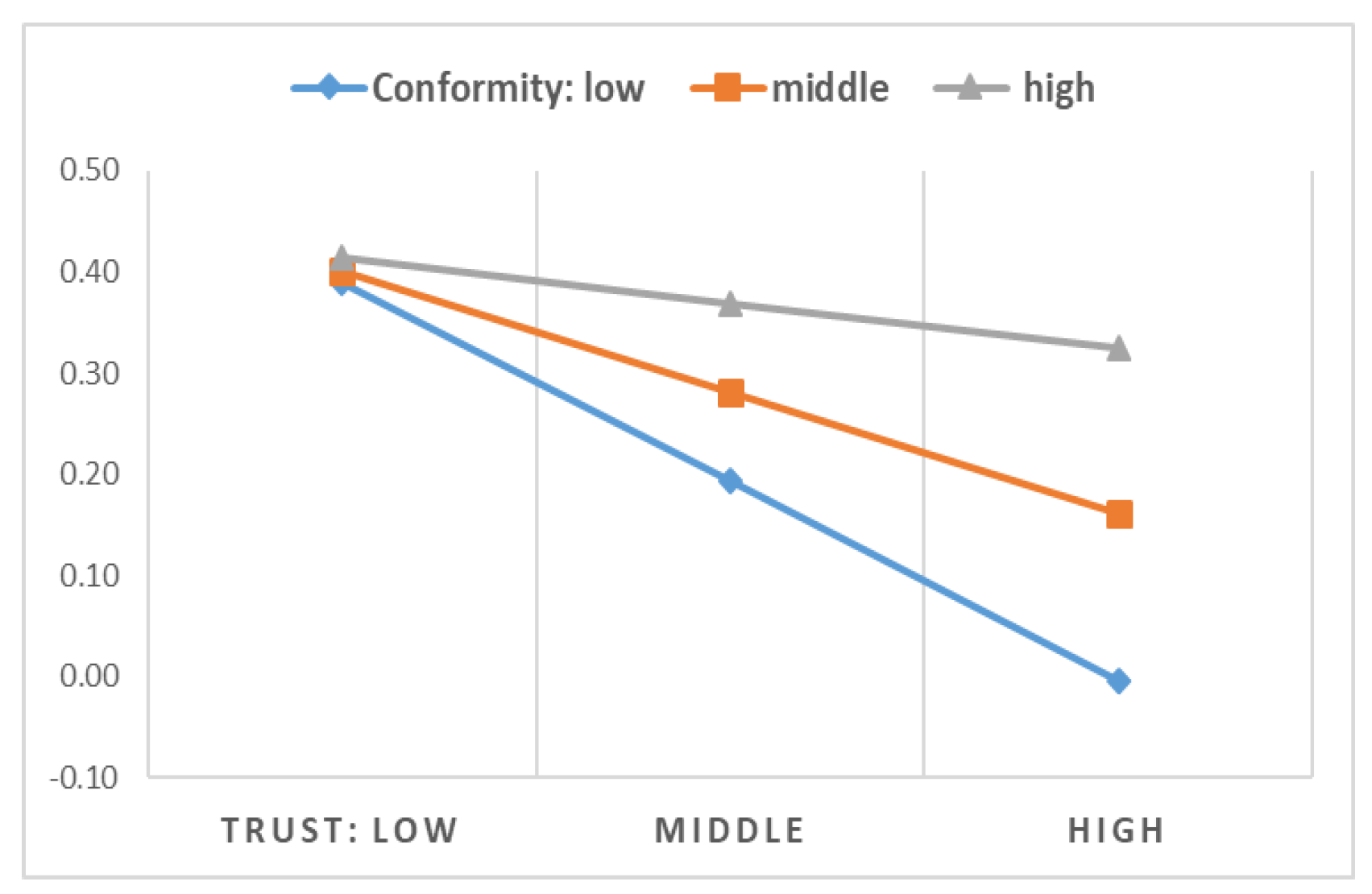
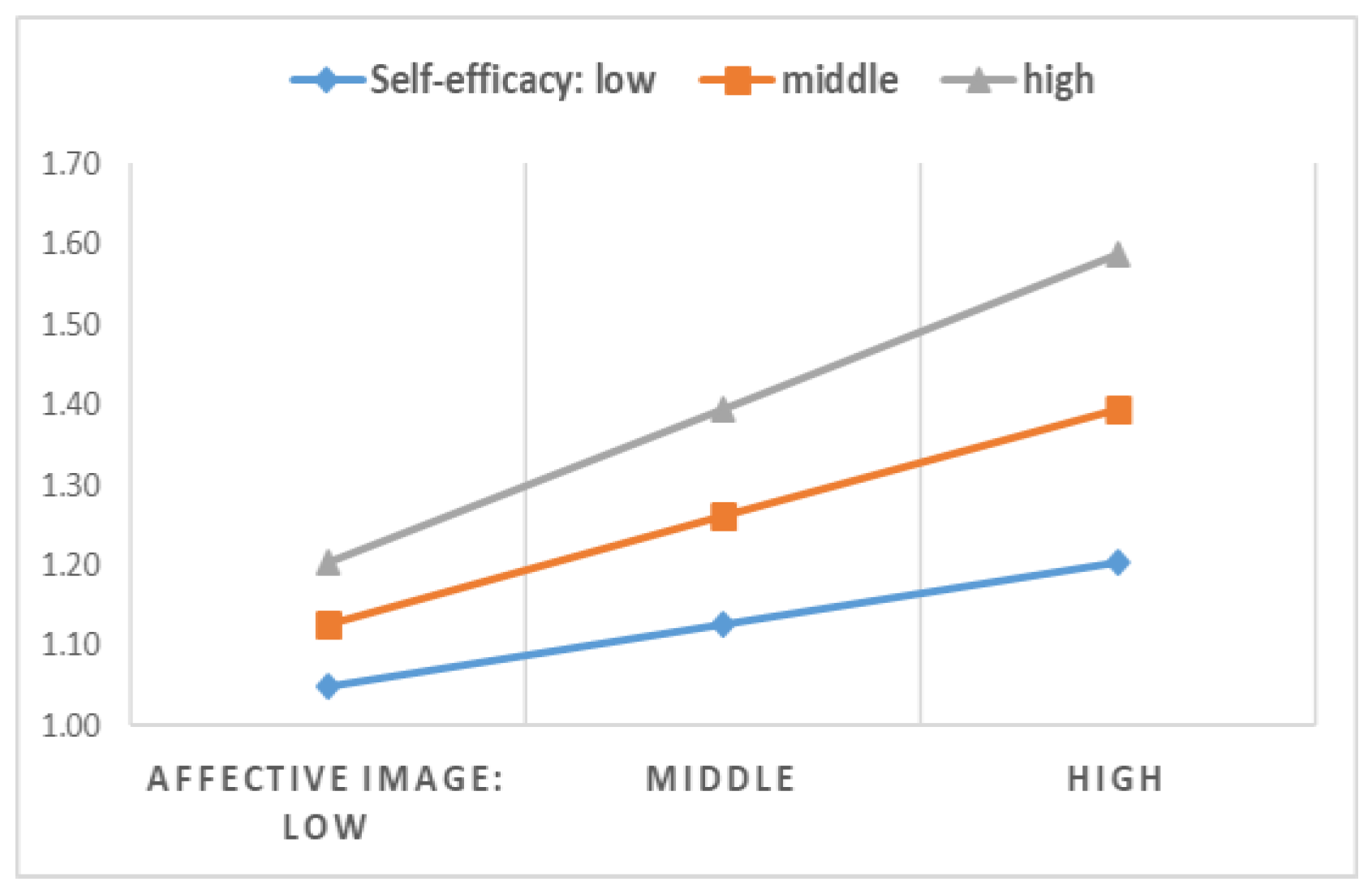
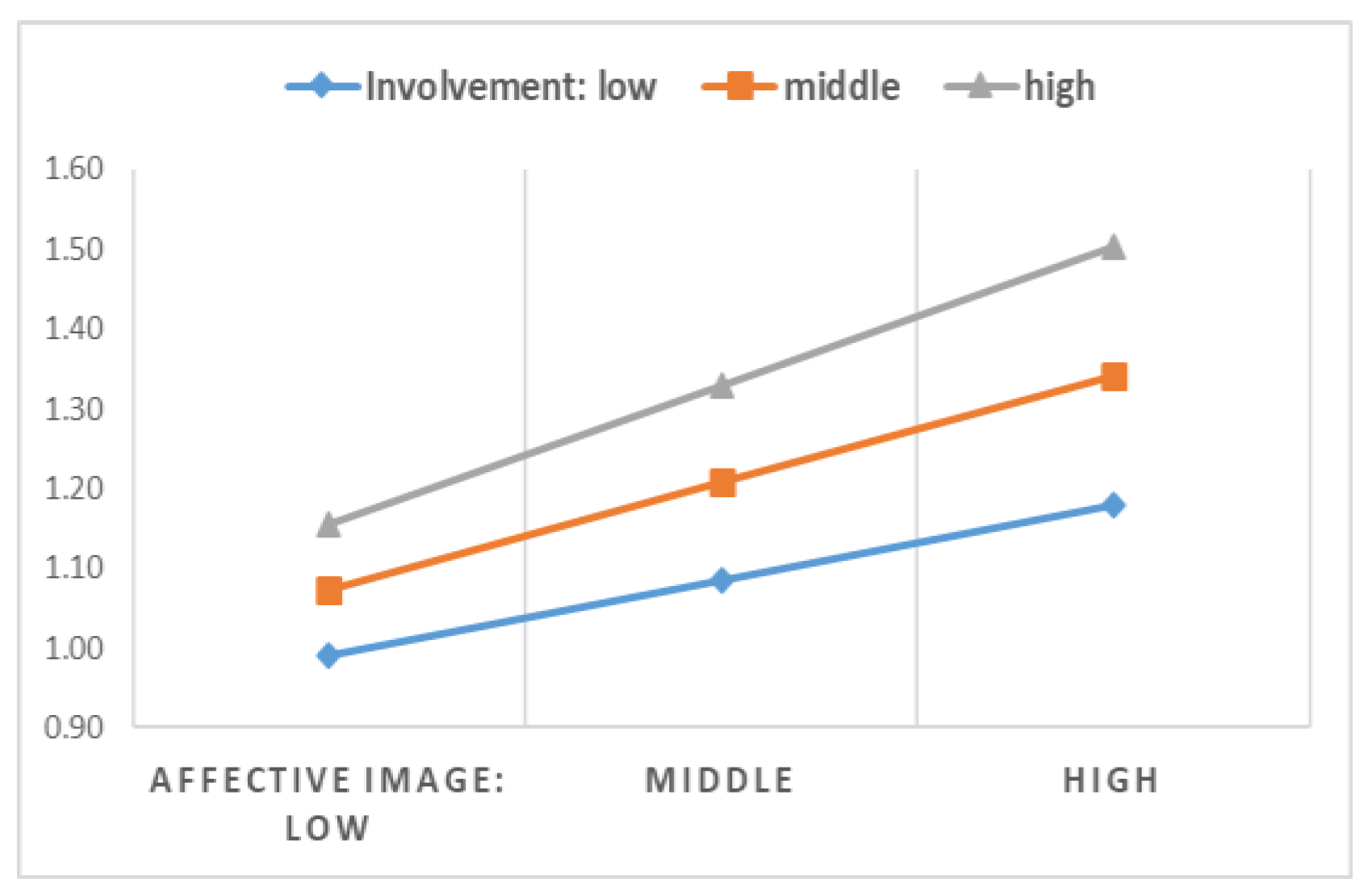
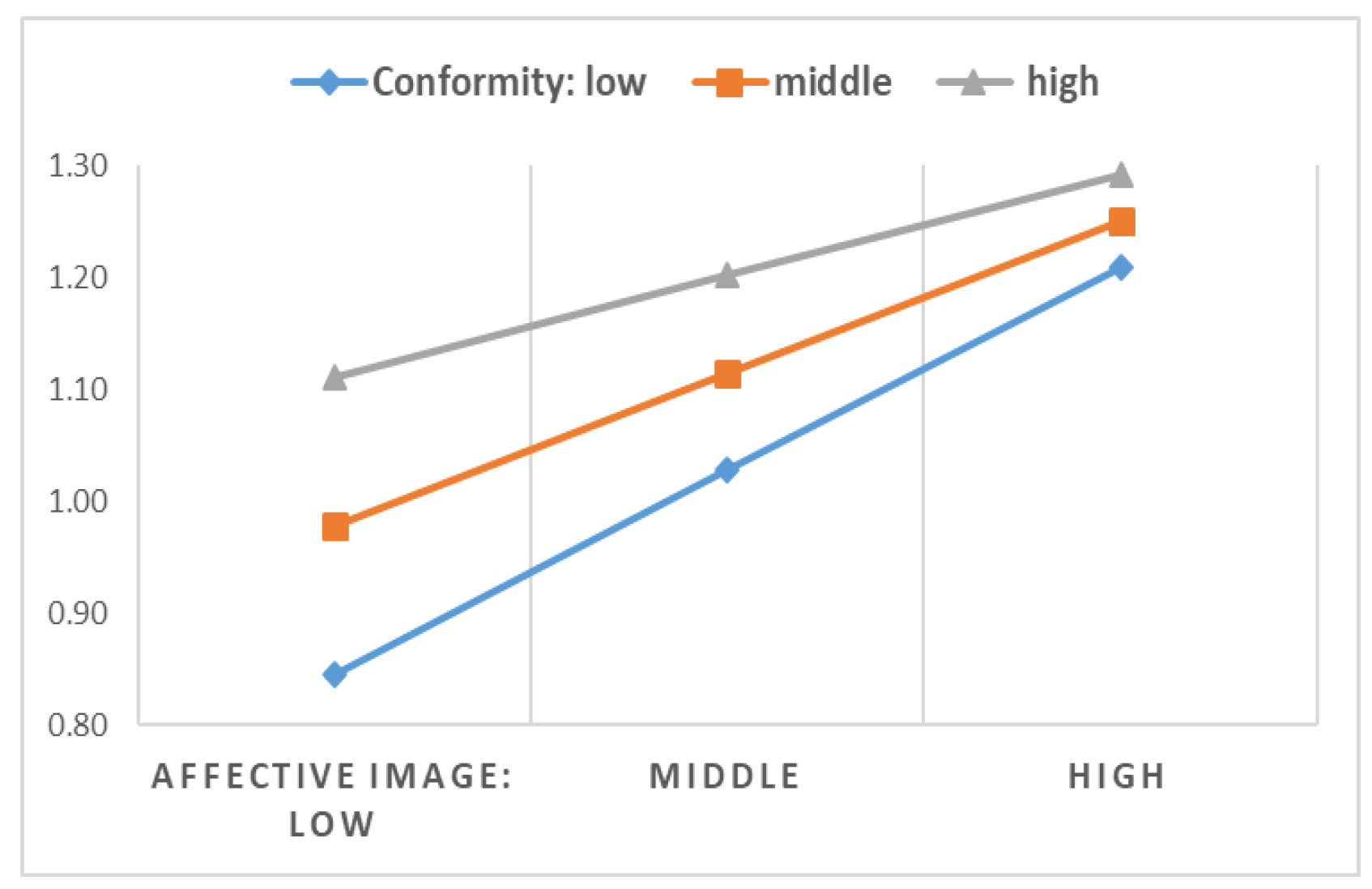
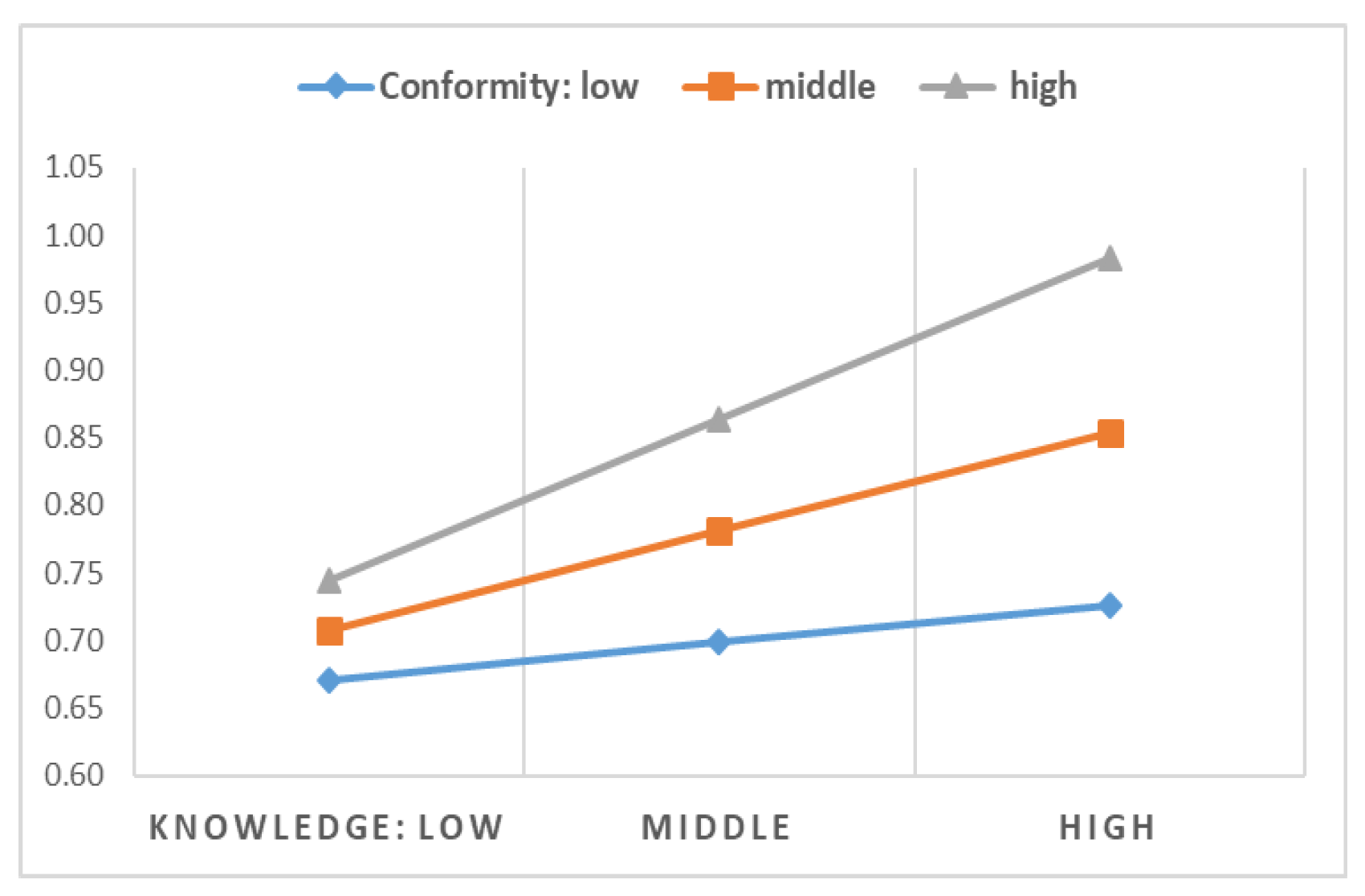
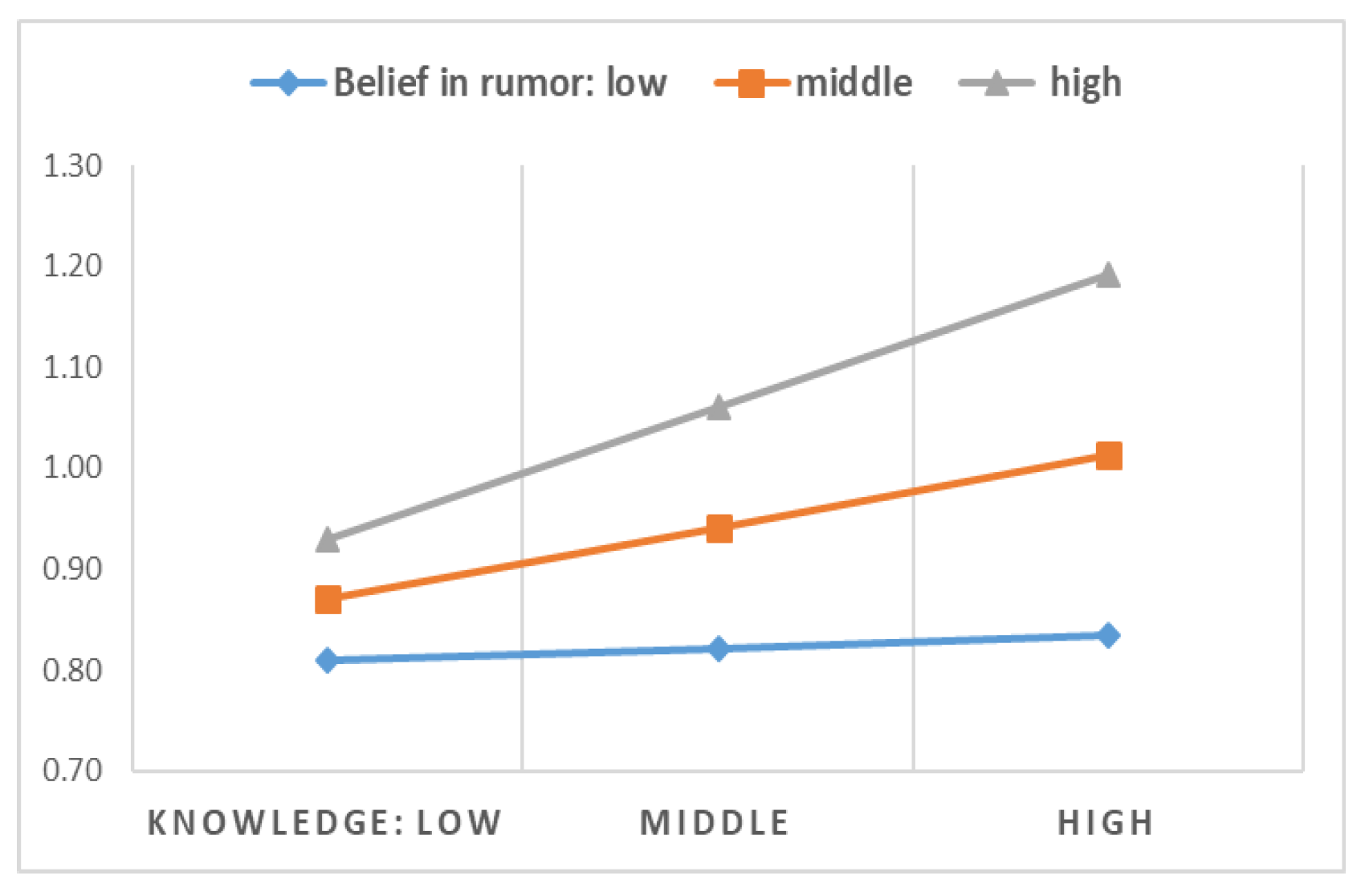
| Variable | Categories | Frequency | Percent (%) | Variable | Categories | Frequency | Percent (%) |
|---|---|---|---|---|---|---|---|
| Age | 20–29 | 302 | 19.2 | Gender | Male | 813 | 51.7 |
| 30–39 | 349 | 22.2 | Female | 759 | 48.3 | ||
| 40–49 | 397 | 25.3 | Social class | Low | 562 | 35.8 | |
| 50–59 | 342 | 21.8 | Middle | 730 | 46.4 | ||
| Over 60 | 182 | 11.6 | High | 280 | 17.8 | ||
| Household income | 300 M.W. | 493 | 31.4 | Ideology | Conservative | 335 | 21.3 |
| 301–500 M.W. | 628 | 39.9 | Neutral | 726 | 46.2 | ||
| Above 500 M.W. | 451 | 28.7 | Liberal | 511 | 32.5 |
| Population | Sample | Percent Gap (A–B) | ||||
|---|---|---|---|---|---|---|
| Variable | Category | Frequency | Percent A (%) | Frequency | Percent B (%) | |
| Gender | Female | 20,348,268 | 49.7 | 813 | 51.7 | −2.0 |
| Male | 20,572,715 | 50.3 | 759 | 48.3 | 2.0 | |
| Total | 40,920,983 | 100 | 1572 | 100 | 0.0 | |
| Age | 20–29 | 6,796,396 | 16.6 | 302 | 19.2 | −2.6 |
| 30–39 | 7,738,472 | 18.9 | 349 | 22.2 | −3.3 | |
| 40–49 | 8,726,984 | 21.3 | 397 | 25.3 | −4.0 | |
| 50–59 | 8,220,296 | 20.1 | 342 | 21.8 | −1.7 | |
| Over 60 | 9,438,835 | 23.1 | 182 | 11.6 | 11.5 | |
| Total | 40,920,983 | 100 | 1572 | 100 | 0.0 | |
| Theoretical Concept | Statement for Measurement | Reliability |
|---|---|---|
| Offline opposition behavior | -Q1. Despite the government’s nuclear safety and regulatory policy, I am willing to participate in a signature campaign against nuclear power. -Q2. Despite the government’s nuclear safety and regulatory policy, I intend to participate in a protest against nuclear power. | 0.843 |
| Online opposition behavior | -Q3. I am willing to participate in an online signature campaign against nuclear power. -Q4. I intend to write statements or comments on the internet against nuclear power. | 0.817 |
| Perceived risk | -Q5. I personally feel that my life is threatened by nuclear power generation. -Q6. Nuclear power generation produces hazardous waste. -Q7. Nuclear power generation is harmful to people’s health. -Q8. Nuclear power plants are dangerous. | 0.808 |
| Perceived benefit | -Q9. Nuclear energy can now contribute to solving climate change problems. -Q10. Nuclear energy can contribute to solving environmental problems. -Q11. Nuclear energy can be supplied cheaply and stably. -Q12. Nuclear power contributes to national economic development. | 0.835 |
| Trust | -Q13. How much do you trust the nuclear safety and risk information provided by each of the following organizations? ① Government, ② President, ③ Ministry of Trade, Industry, and Energy, ④ Nuclear Safety and Security Committee | 0.904 |
| Affective image | -Q14. The following is pairs of words that contrast each other’s feelings about nuclear energy. How does your feeling about nuclear power fall between 1 and 5? - bright ↔ dark - clean ↔ dirty - progressive ↔ retrogressive - good ↔ bad - positive ↔ negative - warm ↔ cold - hopeful ↔ pessimistic - friendly ↔ unfriendly | .892 |
| Knowledge | -Q15. I know institutions that regulate nuclear safety in our country. -Q16. I know the law system related to nuclear safety regulation. -Q17. I can explain issues related to nuclear power to other people well. -Q18. I am well aware of the policies and issues related to nuclear energy. | 0.893 |
| Self-efficacy in cyberspace | -Q19. If I write about nuclear power on the internet, it will be helpful to those who see this information. -Q20. If I share an article about nuclear energy on the internet, it will be helpful to those who see this information. | 0.877 |
| Involvement on the internet | -Q21. I am interested in discussions related to nuclear power energy on the internet. -Q22. I think that debates about nuclear power on the internet are related to my personal interests. | 0.685 |
| Trust in cyberspace | -Q23. Internet users are generally trustworthy. -Q24. Most internet users are honest. | 0.816 |
| Conformity to online opinion | -Q25. If my opinion is different from opinions many people hold, I tend to conform to them. -Q26. I tend to change my opinion to match others’ opinion. | 0.754 |
| Belief in online rumors | -Q27. The majority of the rumors about nuclear power on the internet are mostly true. -Q28. Negative rumors related to nuclear power that spread via the internet are often facts. | 0.802 |
| Concept | Question | N. of Sub-Samples. | Response | |||||
|---|---|---|---|---|---|---|---|---|
| Strongly Disagree | Disagree | Neutral | Agree | Strongly Agree | Total | |||
| Offline opposition behavior | Q1 | N = 1572 | 11.4% | 27.0% | 40.9% | 16.9% | 3.8% | 100% |
| N = 814 | 11.4% | 25.4% | 42.8% | 16.6% | 3.8% | 100% | ||
| N = 591 | 10.5% | 29.4% | 41.6% | 14.6% | 3.9% | 100% | ||
| Q2 | N = 1572 | 17.2% | 34.2% | 38.6% | 8.5% | 1.5% | 100% | |
| N = 814 | 17.2% | 34.2% | 38.2% | 8.6% | 1.8% | 100% | ||
| N = 591 | 15.6% | 34.7% | 39.6% | 8.8% | 1.4% | 100% | ||
| Online opposition behavior | Q3 | N = 1572 | 9.5% | 23.1% | 42.9% | 20.5% | 4% | 100% |
| N = 814 | 9.7% | 21.7% | 44.2% | 20.8% | 3.6% | 100% | ||
| N = 591 | 9.1% | 24.7% | 43.5% | 18.3% | 4.4% | 100% | ||
| Q4 | N = 1572 | 13.9% | 34.7% | 39.6% | 10.1% | 1.7% | 100% | |
| N = 814 | 13.8% | 34.8% | 38.6% | 10.7% | 2.2% | 100% | ||
| N = 591 | 12.5% | 34.7% | 42.6% | 8.3% | 1.9% | 100% | ||
| Gender | Age | Education | Income | |||||
|---|---|---|---|---|---|---|---|---|
| F-Value | p-Value | F-Value | p-Value | F-Value | p-Value | F-Value | p-Value | |
| Online opposition | 13.59 | 0 | 8.09 | 0 | 0.73 | 0.48 | 0.87 | 0.42 |
| Offline opposition | 9.83 | 0 | 8.25 | 0 | 1.62 | 0.20 | 0.95 | 0.39 |
| 1 | 2 | 3 | 4 | 5 | 6 | 7 | 8 | 9 | 10 | 11 | ||
|---|---|---|---|---|---|---|---|---|---|---|---|---|
| Opposition | 1. Offline opposition action | 1 | ||||||||||
| 2. Online opposition action | 0.82 *** | 1 | ||||||||||
| Risk perception paradigm | 3. Perceived benefit | −0.37 *** | −0.33 *** | 1 | ||||||||
| 4. Perceived risk | 0.32 *** | 0.32 *** | −0.34 *** | 1 | ||||||||
| 5. Trust | −0.28 *** | −0.26 *** | 0.040 *** | −0.35 *** | 1 | |||||||
| 6. Affective image | 0.38 *** | 0.34 *** | −0.54 *** | 0.43 *** | −0.43 *** | 1 | ||||||
| 7. Knowledge | 0.14 *** | 0.16 *** | 0.15 *** | −0.06 * | 0.14*** | −0.11 *** | 1 | |||||
| Cyberpsychology paradigm | 8. Self-efficacy in cyberspace | 0.29 *** | 0.31 *** | 0 | 0.01 | 0.05 | -0.01 | 0.35 *** | 1 | |||
| 9. Involvement on the internet | 0.30 *** | 0.33 *** | 0 | 0.12 *** | -0.01 | 0.02 | 0.35 *** | 0.34 *** | 1 | |||
| 10. Trust in cyberspace | 0.26 *** | 0.25 *** | −0.04 | 0 | 0.12 *** | 0.03 | 0.18 *** | 0.29 *** | .19*** | 1 | ||
| 11. Conformity to online opinion | 0.15 *** | 0.17 *** | 0.08 ** | −0.03 | 0.18 *** | -0.07 *** | 0.06 ** | 0.12 *** | 0.24 *** | 0.24 *** | 1 | |
| 12. Belief in online rumors | 0.37 *** | 0.37 *** | −0.29 *** | 0.33 *** | -0.21 *** | 0.30 *** | -0.03 | 0.14 *** | 0.13 *** | 0.19 *** | 0.12 *** |
| Intention to Engage in Offline Opposition Action | Intention to Engage in Online Opposition Action | ||||||||||||||||||
|---|---|---|---|---|---|---|---|---|---|---|---|---|---|---|---|---|---|---|---|
| Model 1 | Model 2 | Model 3 | Model 4 | Model 5 | Model 6 | ||||||||||||||
| B | S.E. | Beta | B | S.E. | Beta | B | S.E. | Beta | B | S.E. | Beta | B | S.E. | Beta | B | S.E. | Beta | ||
| F1: Socio-demographic Factor | Constant | 2.629 | 0.112 | 1.675 | 0.217 | 0.211 | 0.214 | 2.714 | 0.109 | 1.666 | 0.215 | 0.157 | .210 | ||||||
| Age | 0.004 ** | 0.002 | −0.053 | 0.002 | 0.002 | 0.030 | 0 | 0.001 | 0.005 | 0.003 * | 0.002 | −0.050 | 0.001 | 0.002 | 0.022 | -0.001 | 0.001 | −0.008 | |
| Gender | 0.141 *** | 0.045 | 0.079 | 0.071 * | 0.040 | 0.040 | 0.032 | 0.037 | 0.018 | 0.162 *** | 0.044 | 0.093 | 0.108 *** | 0.040 | 0.062 | 0.064 * | 0.036 | 0.037 | |
| Education level | 0.097 | 0.065 | 0.039 | 0.007 | 0.057 | 0.003 | -0.026 | 0.052 | −0.010 | 0.069 | 0.063 | 0.028 | −0.025 | 0.056 | −0.010 | −0.063 | 0.051 | −0.026 | |
| Income | 0.000 * | 0 | −0.049 | 0 ** | 0 | −0.050 | −0.001 *** | 0 | −0.060 | 0 | 0 | −0.030 | 0 | 0 | −0.031 | −0.001 ** | 0 | −0.041 | |
| F2: Risk perception factor | Perceived benefit | −0.222 *** | 0.027 | −0.224 | −0.182 *** | 0.024 | −0.184 | −0.180 *** | 0.026 | -0.186 | −0.140 *** | 0.024 | −0.145 | ||||||
| Perceived risk | 0.159 *** | 0.028 | 0.141 | 0.097 *** | 0.026 | 0.085 | 0.179 *** | 0.028 | 0.162 | 0.110 *** | 0.026 | 0.100 | |||||||
| Trust | −0.080 *** | 0.022 | −0.095 | −0.108 *** | 0.020 | −0.128 | −0.083 *** | 0.021 | -0.101 | −0.107 *** | 0.020 | −0.131 | |||||||
| Affective image | 0.212 *** | 0.033 | 0.179 | 0.182 *** | 0.031 | 0.153 | 0.175 *** | 0.033 | 0.150 | 0.146 *** | 0.030 | 0.126 | |||||||
| Knowledge | 0.218 *** | 0.023 | 0.219 | 0.082 *** | 0.023 | 0.083 | 0.233 *** | 0.022 | 0.239 | 0.088 *** | 0.022 | 0.090 | |||||||
| F3: Cyber factor | Self-efficacy in cyberspace | 0.175 *** | 0.026 | 0.155 | 0.189 *** | 0.025 | 0.172 | ||||||||||||
| Involvement on the internet | 0.162 *** | 0.027 | 0.138 | 0.192 *** | 0.026 | 0.168 | |||||||||||||
| Trust in cyberspace | 0.155 *** | 0.027 | 0.127 | 0.119 *** | 0.026 | 0.100 | |||||||||||||
| Conformity to online opinion | 0.121 *** | 0.027 | 0.096 | 0.131 *** | 0.026 | 0.107 | |||||||||||||
| Belief in online rumors | 0.177 *** | 0.029 | 0.139 | 0.189 *** | 0.028 | 0.151 | |||||||||||||
| F-Value | 5.462 *** | 59.821 *** | 70.549 *** | 5.309 *** | 53.088 *** | 69.235 *** | |||||||||||||
| R2 | 0.014 | 0.256 | 0.388 | 0.013 | 0.234 | 0.384 | |||||||||||||
| Adjusted R2 | 0.012 | 0.252 | 0.383 | 0.012 | 0.230 | 0.378 | |||||||||||||
| R2 change | - | 0.243 | 0.132 | - | 0.221 | 0.149 | |||||||||||||
| Hypothesis * | Reference ** | Result * | Accept/Reject | |
|---|---|---|---|---|
| H1: Perceived benefit → online opposition | − | −0.140/0 in Model 6 | − | Accept |
| H2: Perceived risk → online opposition | + | 0.110/0 in Model 6 | + | Accept |
| H3: Trust → online opposition | − | −0.107/0 in Model 6 | − | Accept |
| H4: Affective image → online opposition | + | 0.146/0 in Model 6 | + | Accept |
| H5: Knowledge → online opposition | − | 0.088/0 in Model 6 | + | Reject |
| H6: Self-efficacy in cyberspace → offline opposition | − | 0.175/0 in Model 3 | + | Reject |
| H7: Involvement on the internet → offline opposition | + | 0.162/.00 in Model 3 | + | Accept |
| H8: Trust in cyberspace → offline opposition | + | 0.155/0 in Model 3 | + | Accept |
| H9: Conformity to online opinion → offline opposition | + | 0.121/0 in Model 3 | + | Accept |
| H10: Belief in online rumors → online opposition | + | 0.177/0 in Model 3 | + | Accept |
| H11: Online variables in cyberpsychology → offline opposition | moderating | 12 out of 25 in interactions | moderating | Partially accept |
© 2019 by the authors. Licensee MDPI, Basel, Switzerland. This article is an open access article distributed under the terms and conditions of the Creative Commons Attribution (CC BY) license (http://creativecommons.org/licenses/by/4.0/).
Share and Cite
Wang, J.; Kim, S. Searching for New Directions for Energy Policy: Testing the Cross-Effect of Risk Perception and Cyberspace Factors on Online/Offline Opposition to Nuclear Energy in South Korea. Sustainability 2019, 11, 1368. https://doi.org/10.3390/su11051368
Wang J, Kim S. Searching for New Directions for Energy Policy: Testing the Cross-Effect of Risk Perception and Cyberspace Factors on Online/Offline Opposition to Nuclear Energy in South Korea. Sustainability. 2019; 11(5):1368. https://doi.org/10.3390/su11051368
Chicago/Turabian StyleWang, Jaesun, and Seoyong Kim. 2019. "Searching for New Directions for Energy Policy: Testing the Cross-Effect of Risk Perception and Cyberspace Factors on Online/Offline Opposition to Nuclear Energy in South Korea" Sustainability 11, no. 5: 1368. https://doi.org/10.3390/su11051368
APA StyleWang, J., & Kim, S. (2019). Searching for New Directions for Energy Policy: Testing the Cross-Effect of Risk Perception and Cyberspace Factors on Online/Offline Opposition to Nuclear Energy in South Korea. Sustainability, 11(5), 1368. https://doi.org/10.3390/su11051368






